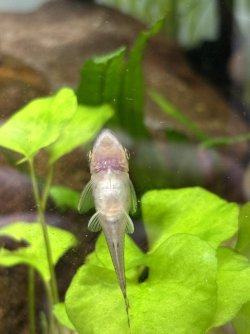🌟 Exclusive Amazon Black Friday Deals 2024 🌟
Don’t miss out on the best deals of the season! Shop now 🎁
You are using an out of date browser. It may not display this or other websites correctly.
You should upgrade or use an alternative browser.
You should upgrade or use an alternative browser.
What is this stubble on my oto’s chin?
- Thread starter Shinyshiny054
- Start date
It's a no worry thing - just the way they grow. They tend to get low key stubble with maturity. It never turns into a hipster beard.
Shinyshiny054
New Member
I can’t tell whether you’re joking or not! So it’s just normal… stubble??It's a no worry thing - just the way they grow. They tend to get low key stubble with maturity. It never turns into a hipster beard.
A lot of fish get stubby (to not so stubby) brushlike growth on their faces and bodies as they become sexually mature. The bristlenose group is the most well known, as theirs can be pretty wild. But variations aren't uncommon in other fish groups.
Shinyshiny054
New Member
And so I’m guessing because oto’s are so hard to sex this happens to both males and females? I have 4 at the moment, one small one I bought back in Feb maybe, and 3 big juicy ones (this one included) that I got a few weeks back. Were these guys just older when I bought them? My other one doesn’t seem to have grown at all but is bright and healthy looking
That I don't know. It's been years since I kept otos, as much as I like them.
And so I’m guessing because oto’s are so hard to sex this happens to both males and females? I have 4 at the moment, one small one I bought back in Feb maybe, and 3 big juicy ones (this one included) that I got a few weeks back. Were these guys just older when I bought them? My other one doesn’t seem to have grown at all but is bright and healthy looking
You won't be able to tell just by size, I'm afraid. "otocinclus" is really an umbrella term for several different subspecies of fish. Because they're easily caught (often stunned using cyanide) and gathered from schools of thousands, in different areas but then mixed into the same warehousing tanks then shipped to stores, they're all generally just sold as otos. You need to know the often subtle differences in their colouration and markings in order to tell exactly which species you have, and since most buyers don't care since their behaviour and needs are the same, they're all usually sold as just 'otocinclus'.
Since you bought yours at different times, it's even more likely that they were collected from a different spot, and could be a different subspecies from your smaller original oto.
Markings can also change as they grow from fry, to juveniles, to adults, making it even harder to tell!
The main exception to this are 'zebra otos' (Otocinclus cocama), simply because they're larger and with much more distinct and attractive colouration, so they're easy to identify and much more expensive than 'regular' otos.
Otocinclus cocama – Zebra Oto — Seriously Fish
There are 22 known subspecies of oto though!
PlanetCatfish.com - The genus Otocinclus
Images are copyright and may not be reproduced without permission of the copyright holder.
(Both Planet Catfish and Seriously Fish are excellent, reliable resources!)
The most commonly found ones sold in stores are O.vittatus, O.affinis, and O.vestitus, from what I've heard and read, but don't quote me on that! Those are the three subspecies I've found, anyway.
I also adopted an oto from a rescue tank that was much larger than any of my other otos, and have no idea which subspecies it was (sadly since passed away), but when it was sitting near my smallest oto, he dwarfed the tiny one! But they were all healthy appearing adults. So size difference doesn't really mean much in terms of maturity or sex.
If you want to deep dive into oto subspecies, there's some fascinating info out there for you, especially if you'd like to breed them! I went through this journey myself, discovering that out of the eight otos I had, I had three different subspecies in the mix. That obviously affects breeding if you don't have enough males/females of the right subspecies, and they're a delicate fish that struggles hard with shipping and aren't easy to breed without ideal conditions for them, and a species only tank. But it's an interesting rabbit hole to dive down. Can learn the different markings to ID your own otos, and learn things like how different subspecies are often found intermingling with and staying near specific species of Corydoras. Scientists think that this is because otos have few defences against predators, while cories have both a toxin and spiked barbs in their fins. The hope is that predators will mistake them for a cory and think otherwise about eating them. I love that random factoid!
Your oto looks well fed and healthy, looks great to me, and I've seen similar whiskers on my otos before, without anything adverse happening! Yours looks healthy and thriving, so you're doing something right!
Similar threads
- Replies
- 7
- Views
- 370
- Replies
- 6
- Views
- 483
- Replies
- 7
- Views
- 492


